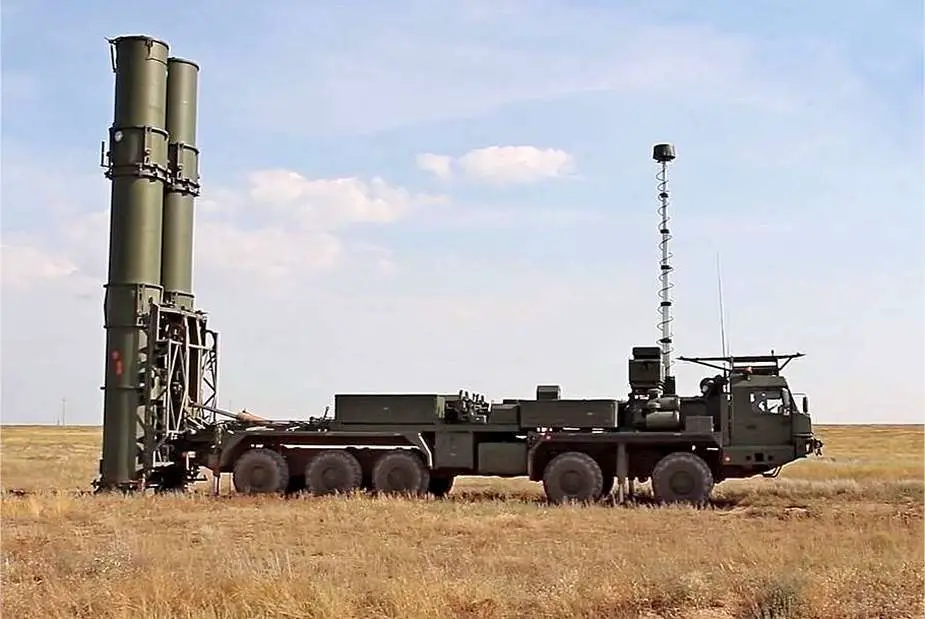Russia to deploy two variants of S-500 Prometheus air defense missile system in Ukraine
On April 23, 2024, Russian Defense Minister Sergei Shoigu announced that the armed forces would receive new military assets by year's end, including the initial deployment of the S-500 Prometheus anti-aircraft missile system in two different configurations. Additional systems such as the S-400, S-300V4, Buk-M3, and Tor-M2U anti-aircraft missile systems, along with new generation radar stations, are also scheduled for delivery. Given the emphasis on air defense systems, it is likely that all these systems are intended for troops in Ukraine.
Follow Army Recognition on Google News at this link

The S-500 air defense system's response time of three to four seconds marks a substantial improvement over its predecessor, the S-400, which has a response time of nine to ten seconds. (Picture source: Russian media)
On April 23, 224, Shoigu announced plans for the Russian military-industrial complex to escalate weapon production in response to what he identifies as increased threats from Western countries. He also noted a significant reduction in the development timeline for these weapons, stating that what previously took five to eight years to produce is now being completed in four to seven months—a pace not seen since World War II.
On Russian media, Oleg Glazunov, an associate professor and expert from the Association of Military Political Scientists, spoke about the strategic importance of the new S-500 air defense system. Glazunov detailed that this system is designed to intercept intercontinental ballistic missiles and engage targets in near-Earth orbit. He claimed that the deployment of such advanced systems is intended to serve as a deterrent, particularly to NATO and American military strategists, by signaling the enhanced air defense capabilities of Russia.
The Russian-made S-500 Prometheus, also known as the 55R6M Triumfator-M, represents a significant advancement in the realm of air defense systems. Developed by Almaz-Antey, this latest generation system is designed to engage and neutralize a wide range of aerial threats, including intercontinental ballistic missiles (ICBMs), hypersonic cruise missiles, and low-orbit satellites, at altitudes up to 200 kilometers.
The S-500 Prometheus, initiated in 2009 with its first prototype completed by 2012, emerged from its predecessors with capabilities far surpassing earlier models. The Russian Armed Forces received their first pre-production prototypes in 2016, as part of a strategic enhancement of their defensive capabilities. The final phase of the S-500's testing was conducted on February 22, 2024, demonstrating its ability to intercept hypersonic targets effectively, which are known for their high-speed, maneuverability, and ability to evade traditional missile defense systems.
A pivotal component of the S-500 is its missile technology. It employs the 77N6-N and 77N6-N1 missiles, both capable of reaching hypersonic speeds and designed for kinetic impacts, delivering precision through sheer velocity. These missiles enhance the system's ability to handle threats at substantial distances, with a reported range of up to 600 kilometers. Furthermore, the system's response time of three to four seconds marks a substantial improvement over its predecessor, the S-400, which has a response time of nine to ten seconds.
The S-500 system is mounted on the BAZ-6909 family of vehicles, known for their high mobility in a variety of terrains. These vehicles support the system's rapid deployment capabilities, essential for maintaining responsiveness in dynamic combat scenarios. The missile launcher unit, the 77P6, and the various command and control vehicles are integral to the system’s operational structure, ensuring that the Prometheus can coordinate defense strategies effectively against complex aerial threats.
The radar systems of the S-500 include the 91N6A(M) acquisition and battle management radar, which allows for the detection and management of multiple targets, enhancing the system’s situational awareness and operational readiness. Other radars such as the 96L6-TsP acquisition radar and the 77T6 ABM engagement radar play critical roles in the detection and engagement processes, securing the airspace against potential threats. Thanks to these radars, the S-500 can engage up to 10 targets simultaneously, an important attribute to counter a technique frequently used by the Ukrainians, where multiple threats are launched at the same time to saturate Russian air defense systems and pierce defense coverage over critical areas or notable assets.























